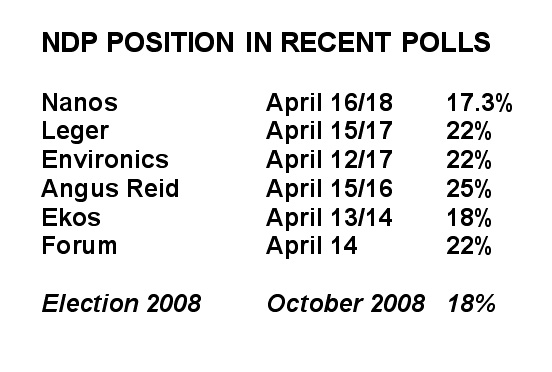Wouldn’t it be ironic if one of the reasons the New Democratic Party and its leader Jack Layton have been doing so well the past few days of this election campaign is the months of ugly negative advertising Prime Minister Stephen Harper’s so-called Conservative party has devoted to destroying Liberal Leader Michael Ignatieff?
This observation is not meant to detract from Layton’s terrific, at times inspiring, performance in two debates and on the campaign trail. Nor is it a denial of the fact that the NDP platform is genuinely closer to what Canadians describe repeatedly in non-partisan polling between elections as the policy mix they truly desire.
Obviously, the NDP’s campaign could not have caught fire without such positive factors in its favour.
Still, it is also true that the Conservatives under Harper have spent well over a year trying to damage the public perception of Ignatieff’s character through a series of vicious pre-writ TV advertisements, a technique they also used to effect with his predecessor as Liberal leader, Stephane Dion.
They pretty much left Layton alone, however. Presumably this was mainly because they viewed him as less of a threat, but also possibly as a tactic to split the centrist vote in Canada.
The Conservatives adopted such tactics, of course, because conservative political parties — small c and Big C, in Canada and in neighbouring countries — are prepared to do almost anything to win. Presumably, they need to spend big and enlist their Rage Machine to make rude late-night calls (from North Dakota, no less) to Ontario voters while pretending to represent Liberal candidates. After all, on their own their policies don’t really do much for most Canadian voters.
So as a general rule, Conservative advertising is designed to obscure, not to illuminate.
The Conservatives adopted such tactics against Mr. Ignatieff and the Liberals — and, sad to say, other political parties are bound to follow them down this twisty path — because negative political advertising works.
It works against honourable statesmen and scurvy self-interested politicians alike. Have no doubt that the Harper Conservatives would have made an effort to create similar doubts about Layton if they had perceived him and his party, early on before the campaign started, to present a threat as serious to them as Ignatieff and the Liberals.
But they didn’t go negative on the NDP. They chose instead to direct their bile and distortions at Ignatieff and his party, whom they viewed as the Main Enemy.
This has allowed Layton’s many strong qualities to shine through, and this, it is written here, has contributed to his success to date in this campaign.
Whatever happens in what’s left of this campaign, it’s doubtful that the Conservatives can use underhanded advertising to undermine Layton’s very positive image with Canadian voters. The reason for this is simple: there just isn’t enough time left before May 2.
The thing is, negative advertising works. But it doesn’t just work (*snap!*) like that.
You have to prepare the ground. It takes time and market penetration to create serious doubts in the minds of voters, especially when you are assassinating the character of an honourable politician. Sometimes months of carpet-bombing are required for the damage to be done. In the case of the professorial Ignatieff, the Conservatives have been going after him for more than a year.
There is another factor in play here that has benefited Layton and the NDP, and that is that when a party makes a decision to go negative, they must do so in the knowledge that their candidate will be hurt a little too. This is because voters don’t like negative advertising, even though they unquestionably respond to it.
Political parties go ahead and go negative because they know it will hurt their opponents more that it hurts their candidate, and because they judge it to be necessary in the context of achieving their goals.
But by going after Ignatieff and inevitably having a little of the smudge rub off on the prime minister, Layton has emerged looking positively saintly. At 13 per cent, that’s no big deal to the Conservatives. At 25 per cent, it could be a problem for them!
Now, we need to keep these results in perspective and not get carried away by our enthusiasm.
The popularity of the NDP in polls taken over the past few days by Nanos, Leger, Environics, Angus Reid, Ekos and Forum ranges from 17.3 per cent to 25 per cent, with three polls placing the party at 22 per cent.
These are extremely good numbers, but they are not that far from 18 per cent, which is where the NDP was on the day of the last federal election, Oct. 14, 2008. That position left the New Democrats as the fourth party in Parliament and their results this time could well be about the same.
Still, the NDP has momentum on its side. As the pollsters at Ekos Research Associates observed, “The New Democrats are the only ones to improve position during the campaign. The party continues to lead as second choice and is now in a better position than it was at this stage of the 2008 campaign.”
This post also appears on David Climenhaga’s blog, Alberta Diary.




